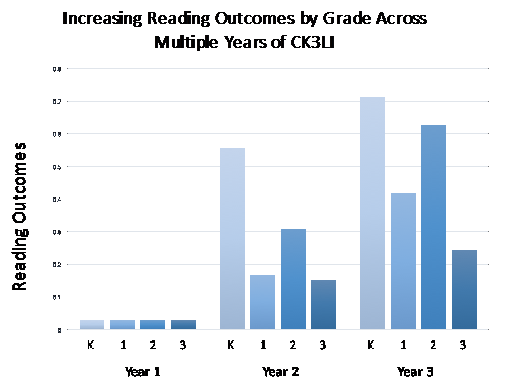Rigorous evaluation data show that students experience greater growth in early literacy skills across grade levels and across literacy measures when their school implements Connecticut’s Literacy Model.
Connecticut’s Literacy Model was evaluated through a series of rigorous research studies that meet the following ESSA evidence standards and recommendations for selecting evidence-based practices.
U.S. Department of Education. (2016) Using Evidence to Strengthen Education Investments.
- Interventions supported by higher levels of evidence, specifically strong evidence or moderate evidence, are more likely to improve student outcomes because they have been proven to be effective.
- SEAs and LEAs should look for interventions supported by strong evidence or moderate evidence in a similar setting and/or population to the ones being served.
More specifically, research studies evaluating Connecticut’s Literacy Model 1) meet the ESSA standards for strong and moderate evidence, and 2) were conducted in schools across multiple Connecticut districts with broad and diverse student populations to provide evidence of generalizability across other Connecticut schools and districts.
Summary of Connecticut’s Literacy Model Research Conducted in Connecticut Meeting ESSA Standards for Strong and Moderate Evidence
Leonard, K., Coyne, M. D., Oldham, A., Burns, D., & Gillis, M. (2019) Implementing MTSS in beginning reading: Tools and systems to support schools and teachers. Learning Disabilities Research and Practice, 34(2), 110-117.
Oldham, A., Gage, N., Coyne, M. D., Leonard, K., & Koriakin, T. (2017, April). A Multi-Tier Approach to Improving Reading Skills of Kindergarten through Third Grade Students: Longitudinal Results of a State Funded Pilot. Poster presented at the Annual Conference of the Council for Exceptional Children, Boston, MA.
Summary: The purpose of this study was to examine early literacy growth across multiple years of implementing Connecticut’s Literacy Model in schools across high priority school districts. We estimated a series of mixed-effects models that allowed us to model the value-added effect of implementing Connecticut’s Literacy Model across consecutive years. Results indicated statistically significant impact on measures of phonemic awareness, word reading, and reading fluency with increasing effects across years of implementation. Results suggest that Connecticut’s Literacy Model had a strong impact on key reading outcomes of students in participating schools and that impacts increased over multiple years of implementation.
What Works Clearinghouse/ESSA Evidence: Meets WWC Standards With Reservations, ESSA Moderate Evidence
Increasing reading outcomes by grade across multiple years of CK3LI

Results suggest that CK3LI had a strong impact on key reading outcomes of students in participating schools and that impacts increased over multiple years of implementation.
Coyne, M. D., Oldham, A., Dougherty, S.M., Leonard, K., Koriakin, T., Gage, N. Burns, D., & Gillis, M. (2018). Evaluating the Impact of Supplemental Reading Intervention within an MTSS or RTI Reading Reform Initiative Using a Regression Discontinuity Design. Exceptional Children, 84, 350-367.
Summary: The effects of the intensive supplemental intervention provided as part of Connecticut’s Literacy Model was evaluated using a regression discontinuity design which allowed us to estimate whether intervention accelerated students reading growth beyond what we would expect if they had not received Connecticut’s Literacy Model intervention. Results indicated statistically significant effects on measures of phonemic awareness, word reading, and comprehension. Results suggest that reading intervention implemented as part of Connecticut’s Literacy Model had a strong impact on key reading outcomes of students most at risk for experiencing reading difficulties.
What Works Clearinghouse/ESSA Evidence: Meets WWC RDD Standards Without Reservations, ESSA Strong Evidence